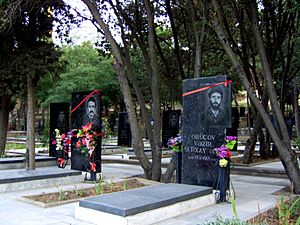Nagorno-Karabakh conflict facts for kids
Quick facts for kids Nagorno-Karabakh conflict |
|||||||||
|---|---|---|---|---|---|---|---|---|---|
| Part of the post-Soviet conflicts | |||||||||
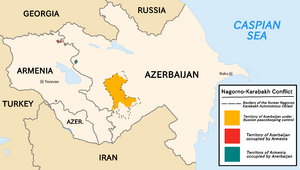 A map of the region before September 20, 2023. |
|||||||||
|
|||||||||
| Belligerents | |||||||||
|
Supported by: |
|||||||||
| Units involved | |||||||||
| Casualties and losses | |||||||||
| Tens of thousands of people were killed throughout the conflict. | |||||||||
The Nagorno-Karabakh conflict was a long dispute between Armenia and Azerbaijan over a region called Nagorno-Karabakh. This area is located within Azerbaijan's borders but was mostly home to ethnic Armenians for many years.
The conflict began in 1988, when both countries were part of the Soviet Union. After the Soviet Union broke apart, the dispute turned into a full-scale war in the early 1990s. Armenian forces won this war and took control of Nagorno-Karabakh and some surrounding areas.
For many years, the situation was tense but mostly stable. However, a second major war broke out in 2020. Azerbaijan won this war and took back most of the territory it had lost. In 2023, Azerbaijan launched a final military operation and gained full control of Nagorno-Karabakh. After this, most of the Armenian population left the region. The conflict officially ended with a peace agreement in 2025.
Contents
Background of the Conflict
The story of this conflict starts in the time of the Soviet Union. Nagorno-Karabakh was set up as a special region, called an autonomous oblast, within the borders of Soviet Azerbaijan. However, most of the people living there were ethnic Armenians.
During the Soviet era, many Armenians in Nagorno-Karabakh felt that their culture was being suppressed. They also felt that the Azerbaijani government was trying to encourage Azerbaijanis to move into the region to change the population balance.
In 1988, as the Soviet Union was becoming weaker, leaders in Nagorno-Karabakh voted to join Soviet Armenia. This decision was based on Soviet laws that allowed for self-determination (the right for people to choose their own government). This vote angered Azerbaijan and led to violent attacks, starting a long and difficult conflict between the two groups.
The Conflict Through the Years
First Nagorno-Karabakh War (1988–1994)
What started as protests and clashes grew into a full-scale war after the Soviet Union dissolved in 1991. Armenia and Azerbaijan became independent countries, and both wanted control over Nagorno-Karabakh. The fighting was intense and took place in the mountainous region.
By 1994, Armenian forces, with support from the local Armenians of Nagorno-Karabakh, had won the war. They took control of most of Nagorno-Karabakh and several surrounding districts in Azerbaijan. As a result of the war, many people were forced to leave their homes. A ceasefire, an agreement to stop fighting, was signed in May 1994. It was arranged with help from Russia.
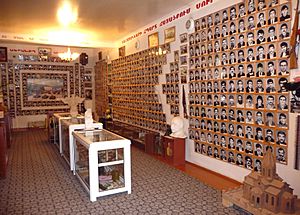
A Tense Ceasefire (1994–2020)
The 1994 ceasefire stopped the major battles, but it did not bring lasting peace. For over 25 years, the situation remained a "frozen conflict." This means the fighting had stopped, but the main issues were not solved.
During this time, both Armenia and Azerbaijan built up their armies. There were often small fights and skirmishes along the "line of contact," which was the frontline separating the two sides. In April 2016, a serious four-day battle broke out, showing that a bigger war could happen at any time.
Second Nagorno-Karabakh War (2020)
On September 27, 2020, a large-scale war began when Azerbaijan launched a major attack to retake the territory. This war was very different from the first one. Azerbaijan used modern technology, including drones, which gave them a big advantage.
The fighting lasted for 44 days and resulted in a clear victory for Azerbaijan. They recaptured all the districts around Nagorno-Karabakh and a significant part of Nagorno-Karabakh itself, including the important city of Shusha.
The war ended on November 10, 2020, with another ceasefire agreement, again arranged by Russia. This agreement confirmed Azerbaijan's territorial gains.
The Final Years of Conflict (2021–2023)
Even after the 2020 war, tensions remained high. Starting in late 2022, Azerbaijan set up a blockade of the main road connecting Nagorno-Karabakh to Armenia. This blockade lasted for months and caused a humanitarian crisis for the 120,000 Armenians living there, who faced shortages of food, medicine, and fuel.
On September 19, 2023, Azerbaijan launched a final, large-scale military offensive. The local forces in Nagorno-Karabakh were quickly overwhelmed. A day later, they agreed to disarm and dissolve their government. Following this, nearly the entire ethnic Armenian population of Nagorno-Karabakh fled the region. By the start of 2024, the self-declared Republic of Artsakh officially ceased to exist, and the region was fully under Azerbaijani control.
Role of Other Countries
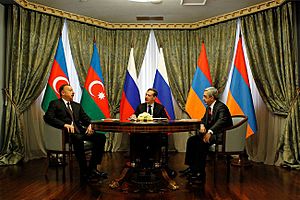
Several countries were involved in the conflict, either as supporters of one side or as mediators trying to find peace.
- Russia played a major role as a mediator. It helped arrange the ceasefires in 1994 and 2020. After the 2020 war, Russia sent peacekeeping troops to the region.
- Turkey was a strong supporter of Azerbaijan. The two countries share close cultural and political ties. Turkey provided military and diplomatic support to Azerbaijan, especially during the 2020 war. It also closed its border with Armenia in 1993 in support of Azerbaijan.
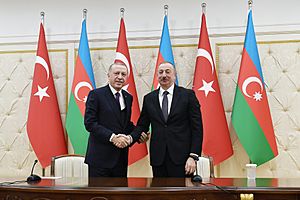
- The OSCE Minsk Group was created in 1994 to help find a peaceful solution. It was led by Russia, the United States, and France. For many years, this group led the peace talks between Armenia and Azerbaijan, but they were unable to reach a final agreement.
The Path to Peace
Over the years, there were several attempts to end the conflict. The first major step was the ceasefire of 1994, which ended the first war but did not create a lasting peace. The second was the ceasefire of 2020, which ended the second war and changed the balance of power in the region.
After Azerbaijan took full control in 2023, the final step was to create a formal peace treaty between Armenia and Azerbaijan.
2025 Peace Agreement
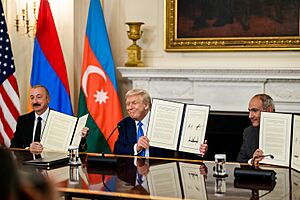
On August 8, 2025, the leaders of Armenia and Azerbaijan signed a historic peace agreement in Washington, D.C., with the United States helping to mediate. This treaty officially ended the conflict that had lasted for more than 35 years. The agreement aimed to establish normal relations between the two countries and close a long and painful chapter in their history.
What Was the Status of Nagorno-Karabakh?
For about 30 years, from the early 1990s until 2023, Nagorno-Karabakh was run by local Armenians as the self-declared Republic of Artsakh. They had their own government, army, and president. However, no country in the world, not even Armenia, officially recognized it as an independent nation. Internationally, it was still considered part of Azerbaijan.
After the events of 2023, the Republic of Artsakh was dissolved. The region is now fully integrated into Azerbaijan, and its political status is no longer in dispute.
Images for kids
-
Photos of fallen Armenian soldiers in Stepanakert, Nagorno Karabakh
-
Azerbaijani President Ilham Aliyev, Russian President Dmitry Medvedev and Armenian President Serzh Sargsyan on 23 January 2012
-
Ilham Aliyev and Turkish President Recep Tayyip Erdoğan on 25 February 2020
-
Joseph Dunford, chairman of the Joint Chiefs of Staff, with Azerbaijani Minister of Defense Zakir Hasanov on 16 February 2017
See also
 In Spanish: Conflicto del Alto Karabaj para niños
In Spanish: Conflicto del Alto Karabaj para niños
- Armenia–Azerbaijan border
- List of ongoing armed conflicts


